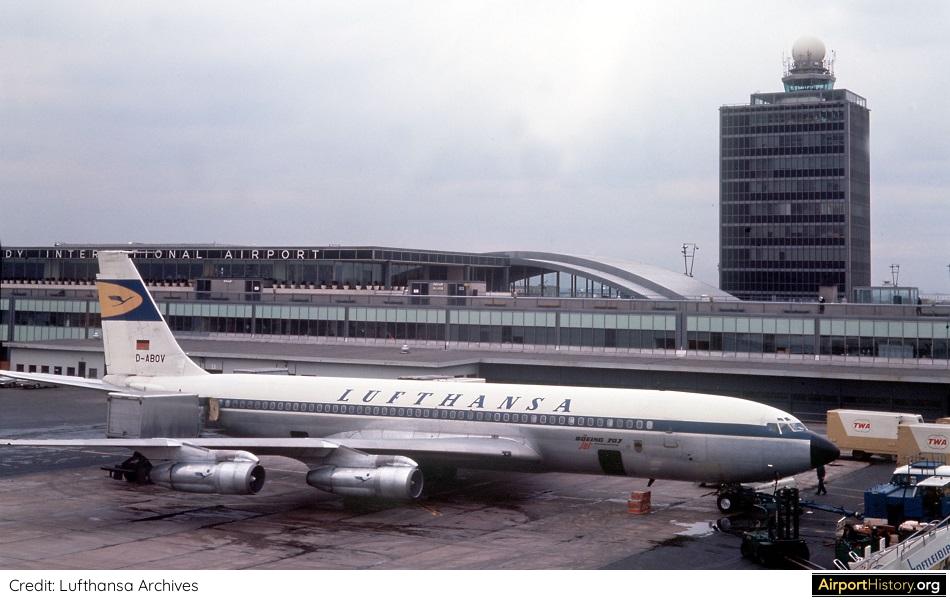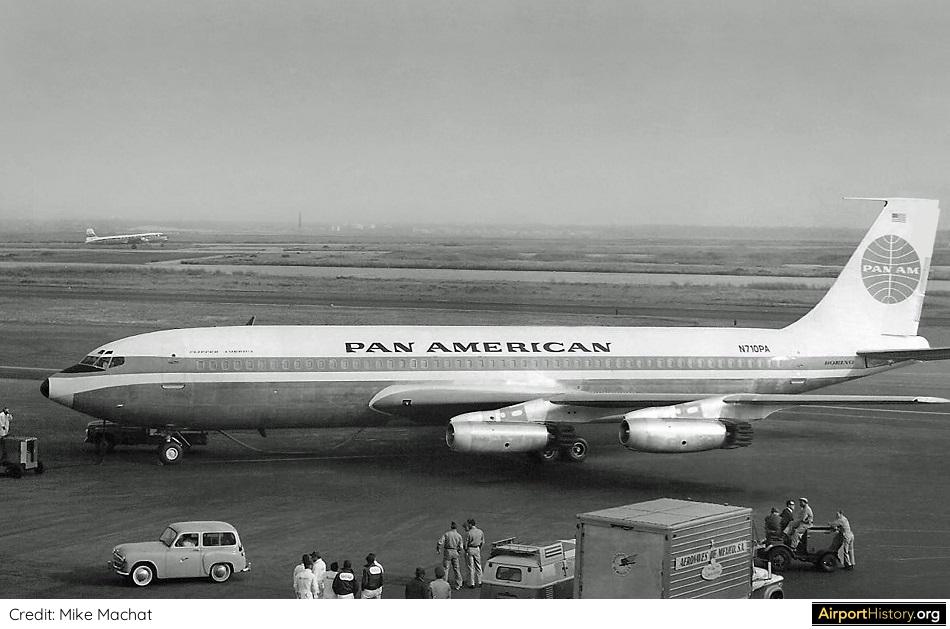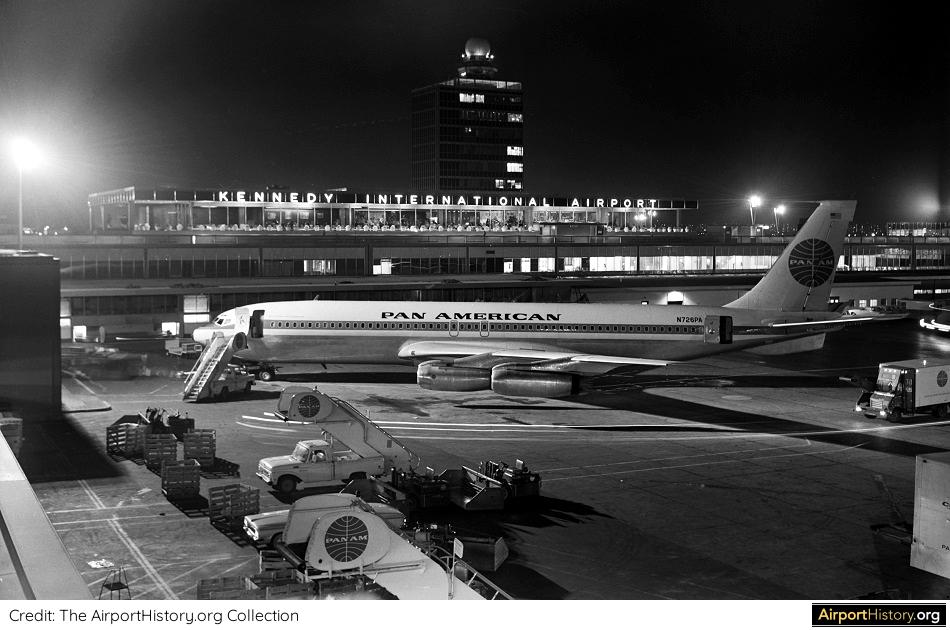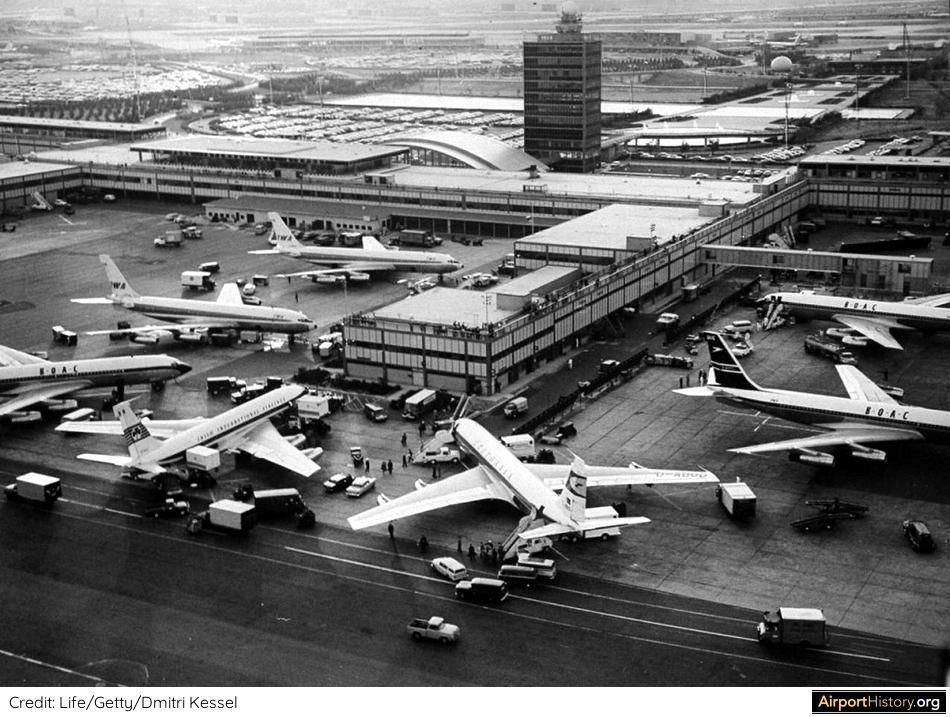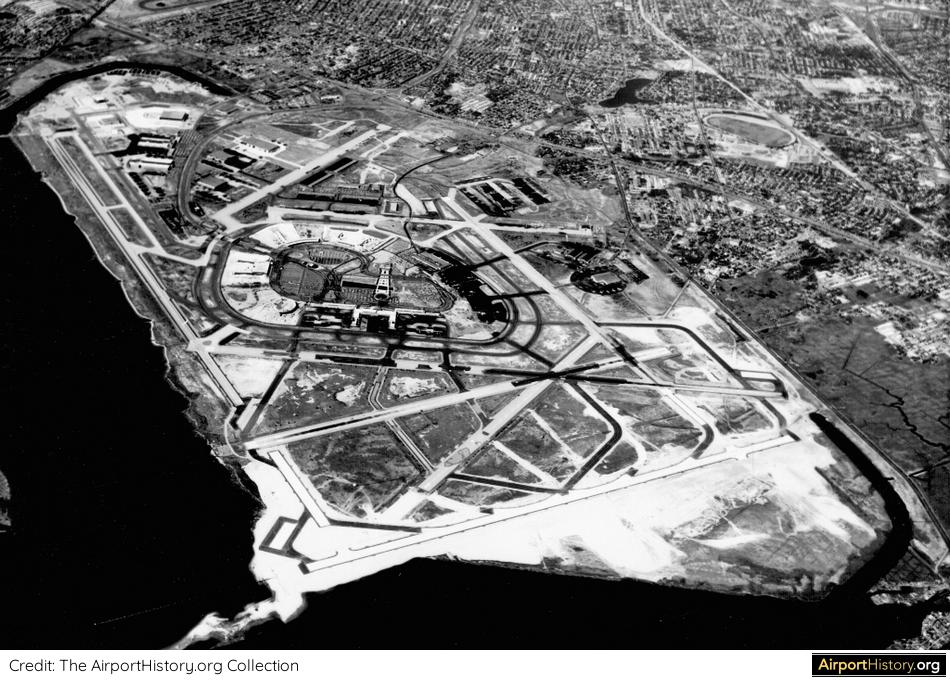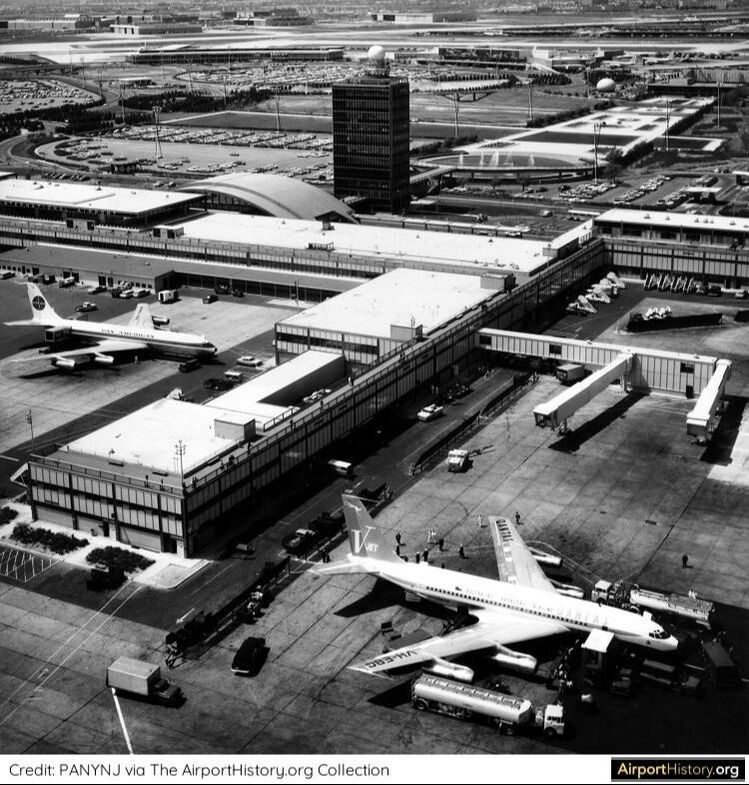Published: March 21, 2019
Updated: January 2, 2020
Updated: January 2, 2020
In this fifth installment of our multi-part history on New York John F. Kennedy Airport, we'll find out how Idlewild dealt with the transition into the Jet Age.
Idlewild enters the Jet Age
A NEW AGE OF TRAVEL BEGINS
The 'Jet Age' presented a huge paradigm shift in air travel. Jet airliners were able to fly much higher, faster and farther than older piston‑ powered propliners, making transcontinental and intercontinental travel considerably faster and easier.
For example, aircraft leaving North America and crossing the Atlantic Ocean (and later, the Pacific Ocean) could now fly to their destinations non-stop, making much of the world accessible within a single day's travel for the first time.
Since large jetliners could also carry more passengers than piston-powered airliners, air fares also declined (relative to inflation), so people from a greater range of socioeconomic classes could afford to travel outside their own countries.
The 'Jet Age' presented a huge paradigm shift in air travel. Jet airliners were able to fly much higher, faster and farther than older piston‑ powered propliners, making transcontinental and intercontinental travel considerably faster and easier.
For example, aircraft leaving North America and crossing the Atlantic Ocean (and later, the Pacific Ocean) could now fly to their destinations non-stop, making much of the world accessible within a single day's travel for the first time.
Since large jetliners could also carry more passengers than piston-powered airliners, air fares also declined (relative to inflation), so people from a greater range of socioeconomic classes could afford to travel outside their own countries.
Terminal City opened just as the Jet Age began in the United States. Idlewild was not the first Jet Age airport. Neither the British-built Comet 1 nor the Russian Tupolev 104 served the airport when first entering service in the 1950s.
However, the first truly successful jet airliner, the Boeing 707, entered passenger service at Idlewild. New York International Airport truly became a true jet age airport as the first generation of Boeing, Douglas and Convair jet airlines entered service, starting in 1958. 1958 also marks the year in which more trans-Atlantic passengers traveled by air than by ship.
However, the first truly successful jet airliner, the Boeing 707, entered passenger service at Idlewild. New York International Airport truly became a true jet age airport as the first generation of Boeing, Douglas and Convair jet airlines entered service, starting in 1958. 1958 also marks the year in which more trans-Atlantic passengers traveled by air than by ship.
By 1959, the Boeing 707 and Douglas DC-8 became a common sight at Idlewild.
FIRST JET FLIGHTS
In August, 1958, Pan American began operating experimental 707 cargo flights to San Juan, Puerto Rico. Later the same year, the first regularly scheduled jet-powered trans-Atlantic flights began when the Comet IV entered into service on the British Overseas Airways Corporation (BOAC) route between Idlewild and London Heathrow, on October 4th.
12 days later a Pan American 707-121 flew a press demonstration flight from Idlewild to Brussels. On October 26th, Pan American started its first scheduled international flight using the 707, when Flight 114 departed Idlewild for Paris Le Bourget Airport. National Airlines initiated the first US domestic jet service on December 10th, 1958, when it inaugurated 707 service from Idlewild to Miami.
In August, 1958, Pan American began operating experimental 707 cargo flights to San Juan, Puerto Rico. Later the same year, the first regularly scheduled jet-powered trans-Atlantic flights began when the Comet IV entered into service on the British Overseas Airways Corporation (BOAC) route between Idlewild and London Heathrow, on October 4th.
12 days later a Pan American 707-121 flew a press demonstration flight from Idlewild to Brussels. On October 26th, Pan American started its first scheduled international flight using the 707, when Flight 114 departed Idlewild for Paris Le Bourget Airport. National Airlines initiated the first US domestic jet service on December 10th, 1958, when it inaugurated 707 service from Idlewild to Miami.
Introduction of commercial jet service was hampered by noise, runway length and aircraft range problems.
|
THE JET AGE TAKES OFF
By 1959, the Boeing 707 and Douglas DC-8 became a common sight at Idlewild. On January 25th, American began service to Los Angeles. On March 20th, TWA began 707 service between Idlewild and San Francisco. Boeing's main competitor, the Douglas DC-8, also made its commercial debut at Idlewild when the type entered service with Delta and United. On September 18th, Delta inaugurated service to Atlanta. United's first DC-8 flight arrived from San Francisco a few hours later. By 1960, the jet age was well underway and all of the major US carriers were operating jet airliners. |
New York's stature as the United States' largest and most important city usually dictated that that airlines--both domestic and foreign--used new aircraft types on Idlewild routes. By the early 1960s, 707s and DC-8s belonging to the major European Airlines became a common sight.
Enjoying this article?
Sign up to our e-mail newsletter to know when new content goes online!
ADJUSTMENT ISSUES
Introduction of commercial jet service was hampered by noise, runway length and aircraft range problems. Idlewild's runway 25, the preferred runway for the departure of jets, was too short for the 707 and DC-8 to take off with a full load of passengers, cargo and fuel.
Runway 13R-31L had enough length, but due to noise abatement procedures, departing aircraft were required to make early turns, which limited the loads. By 1960 two runway (7-25 and 13R-31L) had been extended and a new runway, (4R-22L), built in 1959, became the primary Instrument Flight Rules (IFR) runway. Runway 1-19, restricted to propeller operations and no longer useful, was closed in 1961.
Introduction of commercial jet service was hampered by noise, runway length and aircraft range problems. Idlewild's runway 25, the preferred runway for the departure of jets, was too short for the 707 and DC-8 to take off with a full load of passengers, cargo and fuel.
Runway 13R-31L had enough length, but due to noise abatement procedures, departing aircraft were required to make early turns, which limited the loads. By 1960 two runway (7-25 and 13R-31L) had been extended and a new runway, (4R-22L), built in 1959, became the primary Instrument Flight Rules (IFR) runway. Runway 1-19, restricted to propeller operations and no longer useful, was closed in 1961.
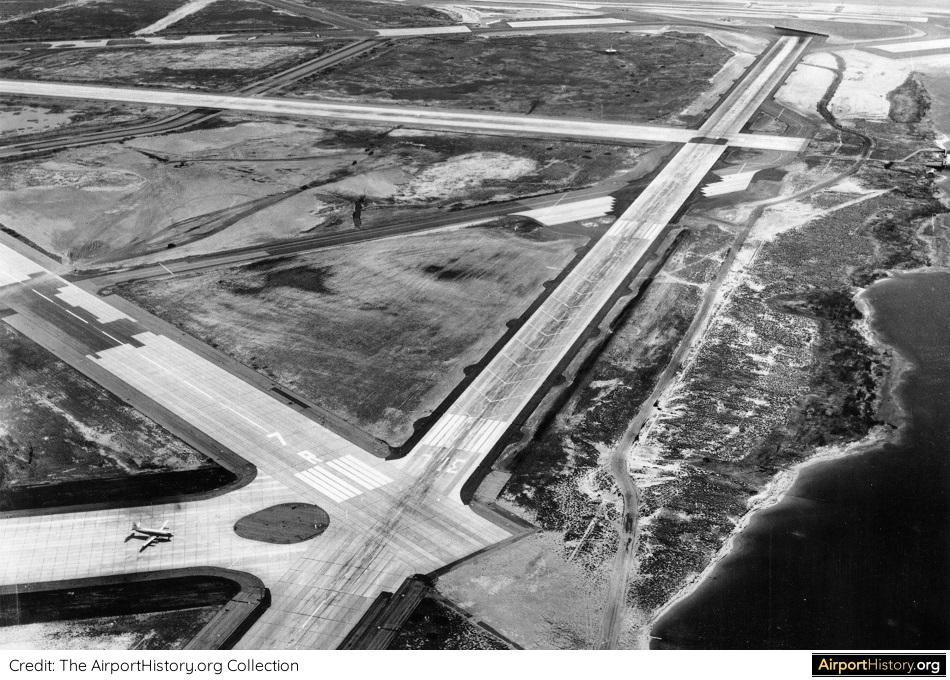
Runway 13R-31L was extended with 3,350 feet (1,022 meter) to 14,600 feet (4451 meter). The extension permitted aircraft to begin their take-off roll further away from the communities west of the airport and to gain additional altitude before reaching these areas. Completed in August 1960, it was the longest commercial runway in North America, until the opening of the 16,000-foot (4,877 meters) runway 16R/34L at Denver International Airport in 2003.
JETS POSE A CHALLENGE FOR THE IAB
Whereas Idlewild's airline terminals had been designed after the big jet programs had been launched, the IAB and Wings were designed when it looked as if the largest airliners--propeller and jet engine--were going to seat around 100 passengers. The Boeing 707 and DC-8 programs were launched only days before construction started. Originally, these planes could seat approximately 120-130 passengers in a two-class configuration.
Whereas Idlewild's airline terminals had been designed after the big jet programs had been launched, the IAB and Wings were designed when it looked as if the largest airliners--propeller and jet engine--were going to seat around 100 passengers. The Boeing 707 and DC-8 programs were launched only days before construction started. Originally, these planes could seat approximately 120-130 passengers in a two-class configuration.
|
During the 1960s this number increased through elimination of the lounges, reduction of first class, and most importantly, by the introduction of economy class. The combined effects of these developments saw the average number of passengers per international arrival more than double from 40 in 1957 to 93 in 1960.
For the IAB to cope, the customs and baggage handling facilities were expanded, thereby boosting the international arrival capacity to ten big jets, or 1,200 passengers, per hour in time for the summer season of 1961. Blast fences were installed to protect the Wing Buildings and allow jet aircraft to taxi out under their own power. A short pier with two boarding bridges was built on the outer side of the eastern arm of the "U" and leased to BOAC. A second one was planned for the use of Air France but was never built. |
We have merely set the stage. In the following chapters we will explore all the airline terminals. Click below to read the next part, where we will explore the first airline terminal to open, that of United Airlines.
Do you have memories of Idlewild in in the early years? Share them below!
Do you have memories of Idlewild in in the early years? Share them below!

